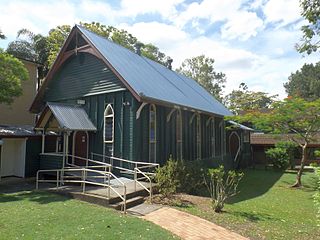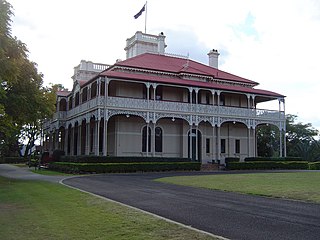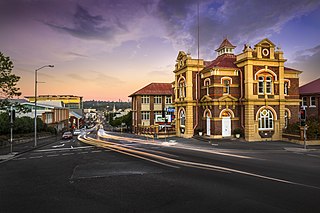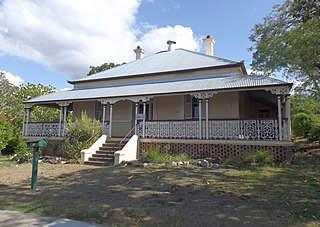
St Andrew's Uniting Church is a heritage-listed Uniting church at 131 Creek Street, Brisbane CBD, City of Brisbane, Queensland, Australia. It was designed by George David Payne and built in 1905 by Alexander Lind & Son. Initially St Andrew's Presbyterian Church, it became part of the Uniting Church following the merger of the Presbyterian, Methodist and Congregational Churches in 1977. It was added to the Queensland Heritage Register on 21 October 1992.

St Agnes Anglican Church is a heritage-listed churchyard at Ipswich Street, Esk, Somerset Region, Queensland, Australia. It was designed by John Hingeston Buckeridge and built in 1889 by Lars Andersen. It is also known as St Agnes Rectory and Church Hall. It was added to the Queensland Heritage Register on 21 October 1992.

Clifford House also known as 'St James' Palace', is a heritage-listed club house at 120 Russell Street, Toowoomba, Toowoomba Region, Queensland, Australia. It was built c. 1865. It was added to the Queensland Heritage Register on 21 October 1992.

Soldiers Memorial Hall is a heritage-listed memorial at 149 Herries Street, Toowoomba City, Queensland, Australia. It was designed by Hodgen & Hodgen (Toowoomba) and built from 1923 to 1959 by Smith Bros (Toowoomba). It was added to the Queensland Heritage Register on 17 December 1999.

Wesley Uniting Church is a heritage-listed former Uniting church at 54 Neil Street, Toowoomba, Toowoomba Region, Queensland, Australia. It was designed by Willoughby Powell and built from 1877 to 1924. It is also known as Wesleyan Methodist Church. It was added to the Queensland Heritage Register on 10 May 1997.

St Andrews Church Hall is a heritage-listed former church and now church hall at 72 Lambert Road, Indooroopilly, City of Brisbane, Queensland, Australia. It was designed by John Hingeston Buckeridge and built from 1889 to c. 1930 by P Christensen. It is also known as Indooroopilly Church of England Sunday School and the temporary St Andrews Church. It was added to the Queensland Heritage Register on 9 July 1993.

St Francis Xavier Church is a heritage-listed Roman Catholic church at 6 Church Street, Goodna, City of Ipswich, Queensland, Australia. It was designed by Andrea Giovanni Stombuco and built in 1881 by William Hanley. It was originally known as St Patrick's Church. It was added to the Queensland Heritage Register on 21 October 1992.

Woodlands is a heritage-listed mansion at Seminary Road, Marburg, City of Ipswich, Queensland, Australia. It was designed by George Brockwell Gill and built from 1889 to 1940s. It is also known as Marburg Campus, Ipswich Grammar School and St Vincent's Seminary. It was added to the Queensland Heritage Register on 21 October 1992.

Hotel Metropole is a heritage-listed hotel at 253 Brisbane Street, West Ipswich, City of Ipswich, Queensland, Australia. It was designed by George Brockwell Gill and built in 1906. It was added to the Queensland Heritage Register on 21 October 1992.

Baptist Church is a heritage-listed former Baptist church at 188 Brisbane Street, Ipswich, City of Ipswich, Queensland, Australia. It began as a simple gabled Gothic Revival building designed by Richard Gailey built in 1877, which was given an Art Deco makeover in 1938, designed by George Brockwell Gill. A memorial gate was added in 1954.

St Paul's Anglican Church is a heritage-listed church at 124 Brisbane Street, Ipswich, City of Ipswich, Queensland, Australia. It was built from 1855 to 1929. It was added to the Queensland Heritage Register on 21 October 1992.

Ipswich Uniting Church is a heritage-listed Uniting church at Ellenborough Street, Ipswich, City of Ipswich, Queensland, Australia. It was designed and built by Samuel Shenton in 1858. It is also known as Ipswich Central Mission, Wesleyan Chapel, Ellenborough Street Methodist Church, and Ipswich City Uniting Church. It was added to the Queensland Heritage Register on 21 October 1992.

Queen Victoria Silver Jubilee Memorial Technical College is a heritage-listed technical college at 88 Limestone Street, Ipswich, City of Ipswich, Queensland, Australia. It was designed by architect George Brockwell Gill and built from 1897 to 1937. It is also known as Ipswich TAFE College and Ipswich Technical College. It was added to the Queensland Heritage Register on 21 October 1992.

Keiraville is a heritage-listed detached house at 20 Roderick Street, Ipswich, City of Ipswich, Queensland, Australia. It was built c. 1880s. It was added to the Queensland Heritage Register on 9 July 1993.

Soldiers' Memorial Hall is a heritage-listed community hall at 63 Nicholas Street, Ipswich, City of Ipswich, Queensland, Australia. It was designed by George Brockwell Gill and built by F.J. Lye from 1920 to 1921. It is also known as Memorial Hall. It was added to the Queensland Heritage Register on 21 October 1992.

St Stephen's Church and Hall, part of the Central Church parish and officially Central Presbyterian Church, Ipswich, is a heritage-listed Presbyterian church and associated churchyard at 22 Limestone Street, Ipswich, City of Ipswich, Queensland, Australia. The church was designed by Joseph Backhouse, built from 1865 to 1978, and added to the Queensland Heritage Register on 21 October 1992.

St Paul's Uniting Church is a heritage-listed Uniting church at 21 MacAlister Street, Mackay, Mackay Region, Queensland, Australia. It was designed by Walter Carey Voller and built from 1898 to 1918. It is also known as St Paul's Presbyterian Church. It was added to the Queensland Heritage Register on 21 August 1992.

Brisbane Grammar School Buildings are a heritage-listed group of private school buildings of Brisbane Grammar School, 24 Gregory Terrace, Spring Hill, City of Brisbane, Queensland, Australia. They were added to the Queensland Heritage Register on 21 August 1992.

Ipswich Girls' Grammar School Buildings is a heritage-listed group of private school buildings at Ipswich Girls' Grammar School, 82 Chermside Road, Ipswich, City of Ipswich, Queensland, Australia. They were built from 1891 to 1968. They were added to the Queensland Heritage Register on 21 October 1992.

Ipswich Grammar School Buildings are a heritage-listed group of private school buildings at Ipswich Grammar School, Woodend Road, Woodend, Ipswich, City of Ipswich, Queensland, Australia. They were built from 1863 to 1972. They were added to the Queensland Heritage Register on 21 October 1992.

























